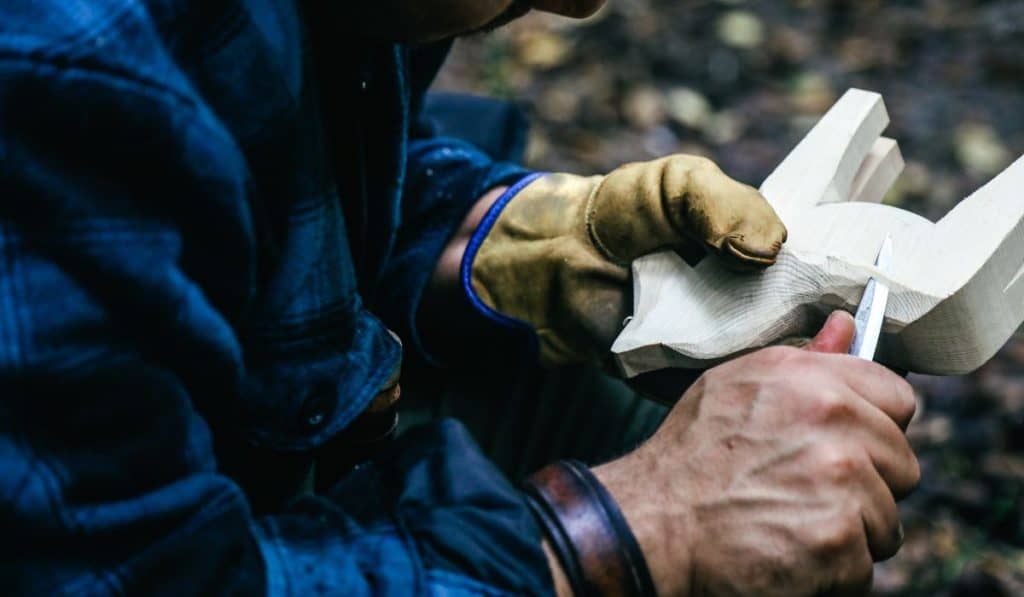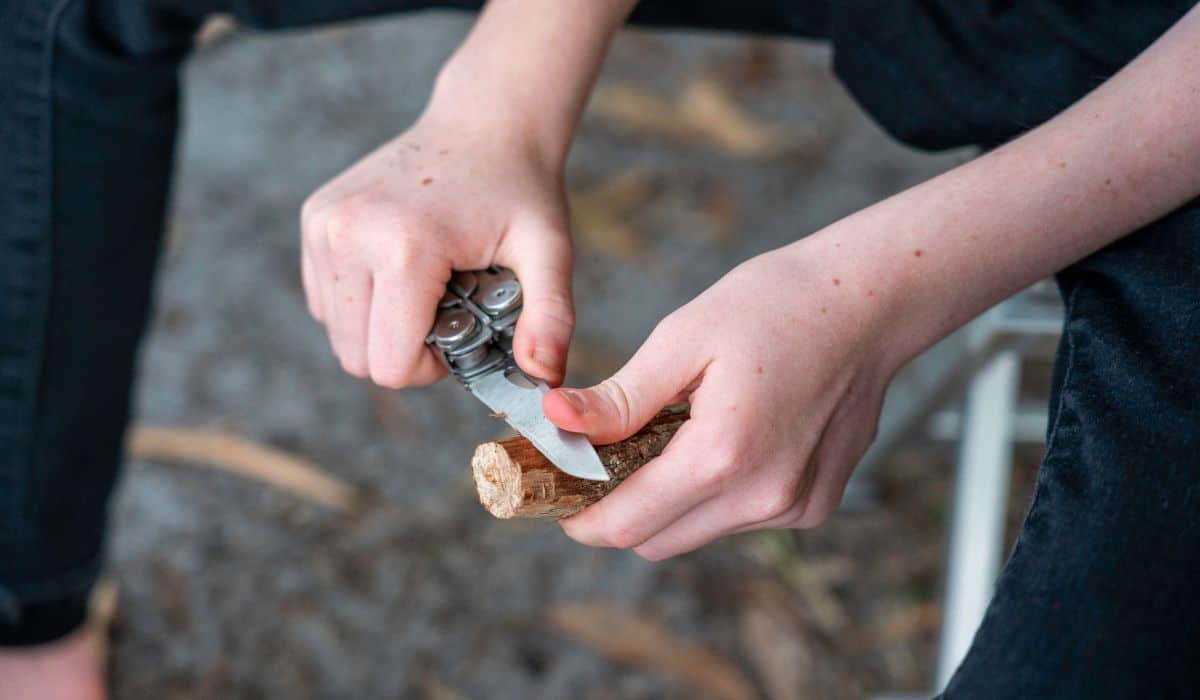Whittling is an ancient art that dates back to when sticks and sharp objects existed.
Although the terms “whittling” and “wood carving” are often used interchangeably, they are different.
Whittling is the act of trimming, cutting, or shaping a piece of wood or a stick using a knife.
Wood carving is quite similar but involves additional tools like gouges and chisels.
The final products from carving are usually more decorative and detailed than just whittling which results in rough edges and fewer details.
It is believed that between 1865 and 1965, whittling was a popular hobby in the United States.
During the Civil War, soldiers from different states came together around campsites to relax.
Their activities included conversation, writing letters, playing cards, and whittling.
Most soldiers had a folding jackknife making them prone to whittling.
Soldiers who got good at it taught others to whittle objects like canes, spoons, smoking pipes, animals, and human figures.
A soldier from one state would teach a soldier from another state and so on.
That’s how it grew into a popular hobby among the soldiers.
When the veterans returned home after the war, they taught this skill to their children and communities.
Why Whittling Is A Good Hobby
Playing with knives is not advisable except when you’re whittling. This is a great hobby to help you relax during your free time.
If you want to make cool objects without spending too much or feeling the pressure of being perfect, whittling is perfect for you. Here’s why you should try it out:
Affordable
Whittling requires minimal investment in terms of money and workspace. As a beginner, you don’t need any skills to start, only interest and a bit of time.
As far as tools are concerned, you won’t need anything more than a knife.
They come in various types and quality; however, you can find a good whittling knife for less than $20.
Creative
Whittling will get your creative juices flowing. There’s no limit to what you can create with a whittling knife and piece of wood.
As a beginner , you can make objects like a wooden spoon, a cat, mushroom, standing shark, bass fish, owl, tobacco pipe, squirrel, baby dinosaur, and many others.
There’s a satisfaction that comes from watching your hands turn a plain piece of wood into an art piece.
Therapeutic
The fast-paced life we have nowadays can be stressful and we need is to slow down and relax.
Whittling is believed to lower stress, heart rate, and blood pressure.
Most whittlers will attest to the fact that this activity is therapeutic, calming, and makes them happy.
Talk about going for therapy without paying for it.
Enhances Concentration and Mindfulness
Whittling is a form of meditation because it keeps you focused. You’re able to fully experience being in the flow.
Time will pass without you even realizing it. This reduces negative emotions while increasing patience and tolerance.
Being in a state of mindfulness gives you a new perspective on stressful situations.
Social Benefits
Whittling is an activity you can do well on your own, but you can also meet as a group of friends or members in your nearby community who love whittling.
Some communities have whittling events and workshops that bring them together.
Many online whittling communities exist as well to provide each other with virtual support.

Muscle and Motor Skill Development
Whittling develops a child’s motor skills and strengthens the arm muscles right from the shoulder to the hand.
For younger children, the new strength in their hand muscles helps them hold a pencil better and improves their writing.
It also develops their hand-eye coordination and keeps them focused.
Connection to Nature
Whittling is a great activity that creates a bridge between you and nature especially if you’re doing it outside.
Nature provides the materials (wood), inspiration, and space for contemplation while you whittle.
Walking through the woods also helps you connect with nature when you learn about different types of trees and their wood.
Business Opportunity
Whittling has the potential to grow from a hobby into a business if you choose to sell your creations.
It’s an opportunity to make money while doing what you love.
This helps you grow your skill and creativity even more as different customers will make orders for a variety of projects that you may never have tried before.
Of course, there’s no pressure, it can always remain just a hobby if you want.
Who Can Whittle?
The great thing about whittling is that it’s an all-inclusive hobby.
As long as you’re interested, can hold a knife and piece of wood, you’re good to go.
From children to teens to adults and then seniors, this hobby is a great relaxing activity.
Children
You’re probably wondering if it’s a good idea to give a child a knife.
Whittling teaches children knife and safety skills and at their age, it’s the best time to learn.
Right from 5 years old, children can take on whittling under the guidance of an adult.
It channels their natural curiosity into something enjoyable and gives them a sense of independence as they learn to assess risk.

Seniors
Whittling is a popular activity with seniors. In some nursing homes and assisted living communities, whittling is one of the activities they engage in.
Staying actively creative keeps their brains alert and enhances memory function, attention span, and problem-solving.
Depending on their age and health condition, their response time and motor skills may not be sharp so safety measures must be taken.
What Equipment Do You Need?
For starters, you won’t need much – only a knife and a piece of wood. You can find a variety of knives at a reasonable cost.
As you get better at whittling, you’ll naturally add more advanced tools to your collection.
Let’s explore what items you’ll be using and what they do.
Pocket Knife
Using a pocketknife is perfect when you’re starting before you invest in an actual whittling knife . Make sure it’s not just any pocketknife.
Ideally, it should have a high carbon steel blade and the blade must be able to lock.
- Whittling Knife: thin pointed tip can be used for delicate cuts and allows working in tight areas. The rounded part of the blade allows cutting in hollow areas and can be used to make slicing cuts.
- Sloyd Knife High Quality Carbon Steel Blade: is made of high-carbon steel and is hardened to proper firmness. The tool is sharpened and polished so you can use it right from the box.
- Wood Carving Knife Cutting Edge: is very sharp, which allows you to cut softwood easily. Wood carving knife’s blade is durable to cut and carve hardwoods such as oak or walnut too.
A non-locking blade will easily lead to accidents as severe as lost fingers.
The convenience is that most pocketknives have multiple blades, and you can keep them safely in your pocket.
Wood Block
After experimenting with random twigs and branches, you can start whittling with actual woodblocks.
Beginner whittlers should start with softwood like pine, bass, and balsa wood.
You should choose a straight-grained piece of wood without knots.
You can find single wood blocks or whittling sets online depending on your preference and budget.
It’s not always easy to determine the direction of the grain on a woodblock. You can only tell when you make a few shallow cuts in the wood.

If you’re cutting with the grain, the wood will smoothly peel away.
If you’re cutting against the grain, you’ll experience resistance and split wood.
The idea is to cut with the grain and not against it or else you’ll have a difficult experience and ugly-looking creations.
The following tools are not mandatory, but they show your seriousness and determination in whittling. They also make your journey a whole lot easier.
Whittling Knife
Today various types of whittling knives exist on the market. Their blades are fixed and don’t fold like pocketknives.
This offers more stability and sturdiness than with a folding blade. Specialty whittling knives generally have curved handles designed to fit in your hand comfortably.
This makes it easy to withstand long whittling sessions. The blade of a good whittling knife should have an extremely sharp blade that is made of carbon steel or stainless steel.
You can buy the knives as singles but whittling knife sets (usually 3) are also available on the market.
Sharpening Tools
Whittling is so much easier when you have a sharp knife. A sharp knife is more useful and safer to use.
You will have better control of a sharp knife because you can push it easily through the wood.
Imagine how hard it would be trying to push a blunt knife through the wood. You could easily get injured.
Sharpening your whittle knife is easy and will require a few tools.
- A two-sided sharpening stone
- Sandpaper
- Leather strop
To sharpen your knife using a sharpening stone, place the blade on the stone at a slight angle facing you.

With a blade on the stone, push the knife away from you in a few strokes.
When using sandpaper, attach it to a firm object like a brick. Place the blade on the sandpaper at a 22° angle.
Stroke the blade gently across the sandpaper, ensuring that its tip gets sharpened too. Use light pressure moving the knife away from you.
Gloves and Thumb Guard
A glove will protect your fingers from being sliced and give you a firm grip on your object.
If you’re careful enough, you’ll hardly get injured while whittling but who wants to take any chances?
It’s better to be safe than sorry. Some whittlers use only a thumb guard , others use whittling gloves. Some use both.
It’s best to wear the glove on the hand that holds the woodblock as it’s more at risk of injury.
- Split Leather
- Elastic Cloth Backing
- Closed end for fit and safety
- Priced per pair – Adult Male size
- WoodRiver is proudly made by Woodcraft, America’s leading supplier of high-quality woodworking hand tools, power tools, domestic and exotic wood, shop supplies, project plans and kits, plus so much more! Offering first-rate products for all your woodworking needs and designed to help you make wood work. Our family of brands include Woodcraft tools and supplies, Highpoint professional-grade fasteners and hardware, Pinnacle precision-engineered tools and Woodcraft Magazine.
The thumb guard is for the thumb the hand that’s holding the knife.
It’s especially helpful with whittling methods like the push or pull stroke which can harm your thumb.
The two most common types of gloves are steel mesh and Kevlar.
These materials are the best because they protect you from cuts and slices. However, they are not puncture-resistant.
Safety Glasses
As you whittle away, there’s always that occasional flying wood chip that might land in your eyes if they aren’t protected.
Cover your eyes every time you whittle with safety glasses.
How to Whittle
Now that you know what this amazing hobby is about and the equipment you need, let’s look at what the basic process of whittling is like.
Of course, the best way to learn to whittle is directly from someone else who has mastered the art.
Follow the safety guidelines and keep practicing until you get good at it. Don’t feel pressured to be perfect.
Like most hobbies, everyone is nervous the first time around.
Types of Whittling Cuts
Whittling entails several cutting styles, but you only need to know three official techniques.
It doesn’t matter whether you’re right-handed or left-handed. The instructions apply either way.
Straightaway Rough Cutting
This cut comes first because it creates the general shape and outline of your project.
Holding the wood in one hand and your sharp knife firmly in the other, make long, sweeping cuts with the grain going away from your body.
Cutting deeply will split the wood and you don’t want that. Simply make thin slices to remove the wood you don’t need.
Push Stroke (Thumb Pushing)
Now you’re starting to shape your object by cutting while pushing the knife away from you. This stroke gives you excellent control over your knife.
Holding the wood in one hand and the knife in the other, make sure the blade is facing away.
Place both thumbs on the back of the blade and push forward.
Your cutting hand should steer the blade through the wood to create smooth cuts.
Pull Stroke (Pare Cut)
This is the most commonly used and useful cutting technique. It offers you great control and accuracy and is perfect for detailed cuts.
However, it’s riskier because you pull the blade towards you.
This technique is also called the “pare cut” because it is a similar stroke to paring or peeling.
Hold the woodblock in your none-cutting hand and the knife in your dominant hand.
The blade should be facing towards you. Brace the thumb of your dominant hand against the wood, then squeeze your fingers (of that same hand) so that you can pull the blade towards you in short, controlled strokes.
Your thumb should be out of the blade’s path. It’s advisable to wear a thumb pad for this stroke.
Where to Learn Whittling
Like most skills and hobbies, there’s always someone ready and willing to teach you.
There might be a whittling class in your area. Ask around for referrals or better still, use the internet.
Type in your search engine bar for “whittling classes in (your area)” to find out.
Physical classes aren’t the only way to learn in this digital era. Almost every hobby has online classes and whittling is no exception.
Online spaces like Perennial offer virtual whittling classes via Zoom for beginners where you’ll learn the basics of the skill hands-on.
You can also find books on whittling. For beginners, starter guides are great resources to guide you step by step.
They contain how-to photos with easy-to-follow instructions. They also include ready-to-carve patterns and easy projects you can create.
Final Thoughts
Hopefully by now, playing with knives doesn’t sound so scary after all. Whittling has great health benefits for everyone and doesn’t cost much to start.
With this hobby, you’re only as limited as your imagination. Give it a try and see where your creativity takes you.




